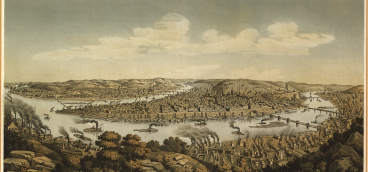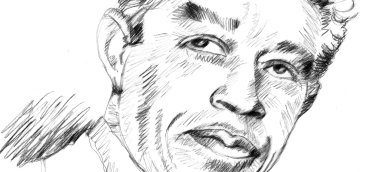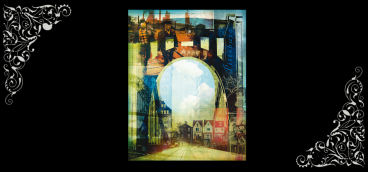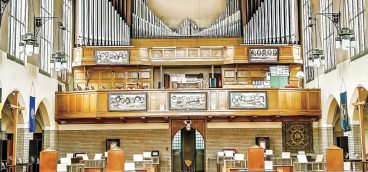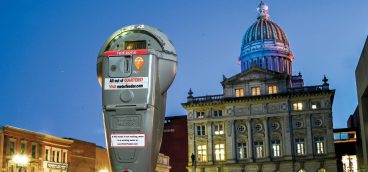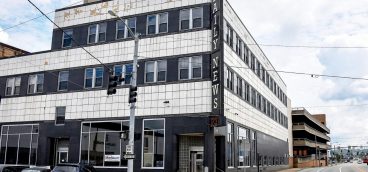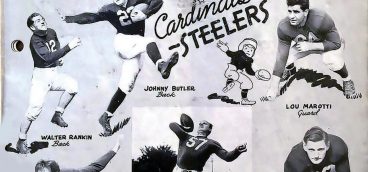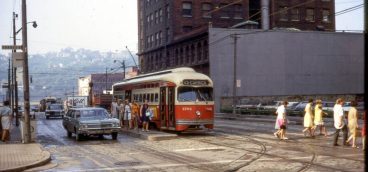Pittsburgh’s Contributions to the World, Pt. V
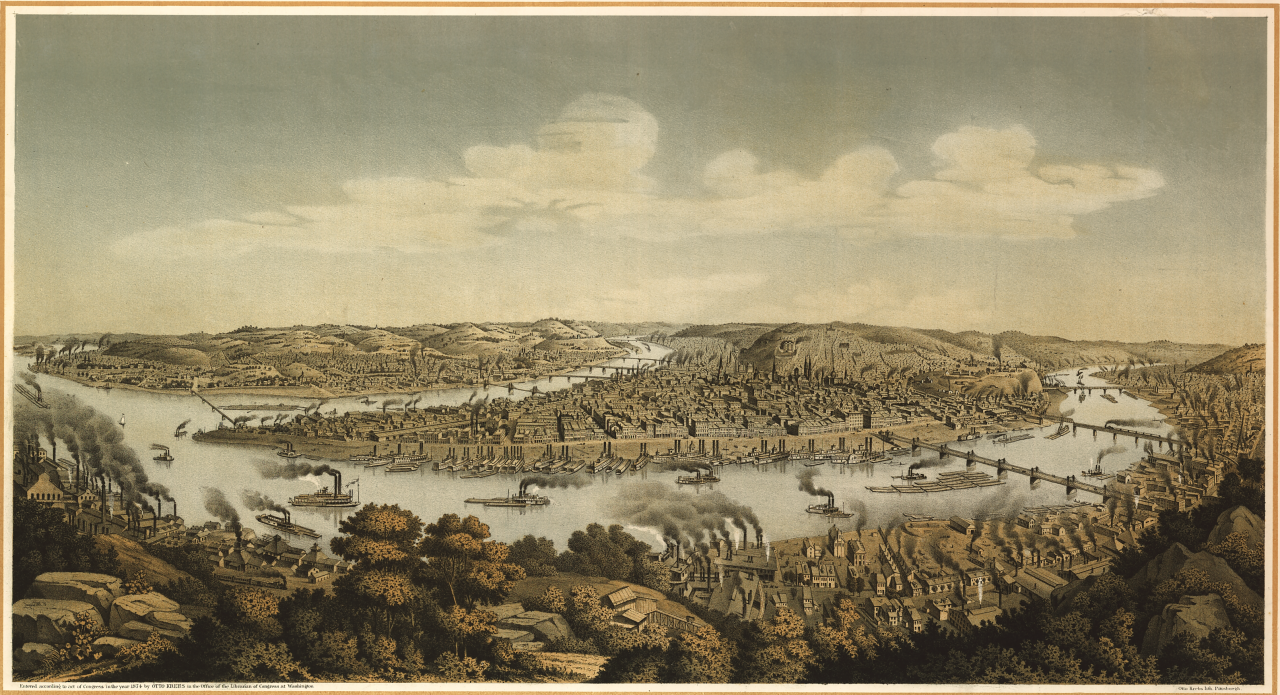
To celebrate the beginning of our 20th year, we’ve set out to catalogue the contributions that Pittsburgh and western Pennsylvania have made to the world. The list has grown and grown, and despite our best efforts, we know we’ll leave out key contributors. I think you’ll find that this small city at the confluence of three rivers has played an astonishingly outsized role in the creation of this country and the world we inhabit. So, read on, and be inspired to pick up the gauntlet and take your turn in building this great American city – Douglas Heuck
Primanti’s – Fries in a Sandwich
Primanti Bros., a Pittsburgh institution, is famous for the signature sandwiches topped by coleslaw and French fries. Created in the 1930s for truckers who needed a quick, portable meal, the unique combination became a local tradition. The original restaurant remains in the Strip District, though Primanti’s is now a chain with 43 locations.
Boxing Champs:
Frank Klaus was a World Middleweight Champion with a rugged and aggressive style. Born in Pittsburgh in 1887, Klaus claimed the middleweight title in 1913.
Harry Greb was one of the most skilled and relentless boxers in history. Born in Pittsburgh in 1894, he was called “The Pittsburgh Windmill” because of his aggressive, non-stop fighting style and incredible stamina. Over his career, he fought an astounding 298 bouts, earning a record of 261 wins, many of them against larger opponents. Greb’s most notable achievement was winning the World Middleweight Championship in 1923. Greb died at 32 from complications following surgery.
Teddy Yarosz was a World Middleweight Champion born in 1910 in Monaca. Known for his elusive footwork and defensive skill,
Fritzie Zivic, aka “The Croat Comet,” was part of a prominent boxing family and known for his crafty, sometimes controversial, tactics in the ring. He won the World Welterweight Title in 1940.
Billy Conn, was a legendary Pittsburgh boxer born in 1917. Known for his speed, skill, and toughness, Conn became the World Light Heavyweight Champion in 1939. His most famous fight was a 1941 bout against heavyweight champion Joe Louis, where Conn came close to an upset victory before being knocked out in the 13th round.
Paul Spadafora achieved fame as a lightweight champion. Born in 1975 in McKees Rocks, Spadafora held the IBF Lightweight title from 1999 to 2003 and remained undefeated in his first 48 fights.
The Negro Leagues
The Pittsburgh Crawfords owe much of their success to Gus Greenlee, a savvy businessman and team owner. Greenlee purchased the team in the early 1930s and transformed the Crawfords into a powerhouse by recruiting legendary players Josh Gibson, Satchel Paige, and Cool Papa Bell. The team won the Negro League championship in 1935. Greenlee also built Greenlee Field, one of the few black-owned ballparks in America, providing a home for the Crawfords and a source of pride for Pittsburgh’s black community.
The Homestead Grays were led by Cumberland Posey, a visionary owner and manager. Considered one of the most influential figures in Negro League history, Posey built the Grays into a dominant force, winning numerous championships. Posey had a keen eye for talent and recruited stars Josh Gibson and Buck Leonard. As a businessman and community leader, he helped elevate the status of black athletes and provided opportunities during a time of segregation. His induction into both the Baseball Hall of Fame and the Basketball Hall of Fame reflects his extraordinary contributions to sports and civil rights.
Josh Gibson was considered the “Black Babe Ruth,” one of the greatest power hitters in baseball history. Born in Buena Vista, Georgia, in 1911, he moved to Pittsburgh as a young man and became a star player with the Pittsburgh Crawfords and Homestead Grays. Known for his prodigious home runs, Gibson was a dominant force at the plate, and some estimates credit him with hitting over 800 career home runs. Despite being barred from Major League Baseball due to segregation, he was posthumously inducted into the Baseball Hall of Fame in 1972, solidifying his legacy as a pioneer and symbol of excellence.
Fallingwater – Frank Lloyd Wright’s Masterpiece
Perhaps the second-most famous house in America (behind the White House), Fallingwater is the architectural masterpiece designed by Frank Lloyd Wright for the Kaufmann family of department store fame. Located in Mill Run, Fayette County, it was built in 1935. Positioned over a waterfall, Fallingwater exemplifies Wright’s philosophy of organic architecture, which seeks harmony between human habitation and the natural world. The house’s design, featuring cantilevered terraces and local materials, became an icon of modern architecture. Praised for its bold engineering and aesthetic beauty, Fallingwater earned recognition as a National Historic Landmark and a UNESCO World Heritage Site. Today, Fallingwater is open to the public as a museum, attracting visitors from around the globe.
Robert L. Vann and the Pittsburgh Courier – A Great Black Newspaper
The Courier was one of the most influential African American newspapers in the United States during the 20th century. Founded in 1907, it became a powerful voice for civil rights, addressing issues such as segregation, discrimination, and economic inequality under the leadership of editor Robert L. Vann. It played a key role in advocating for the Double V campaign during World War II — promoting victory against fascism abroad and racism at home. At its peak, the Courier reached a national audience and helped shape the narrative of the African American experience in America. Vann was an influential political figure who encouraged African Americans to shift their support to the Democratic Party during the New Deal era. The New Pittsburgh Courier still publishes today under the leadership of Rod Doss.
Aaron Gorson – Painter of Steel Mills
Gorson is known for his atmospheric depictions of Pittsburgh’s industrial landscapes, capturing the beauty of the city’s mills and smokestacks in a way that celebrated their grandeur. Born in Lithuania in 1872, he immigrated to the U.S. and studied art in New York and Paris before settling in Pittsburgh. His work uniquely combined realism with impressionistic techniques, portraying the interplay of light and smoke over industrial settings.
Andrew Mellon’s Gift – The National Gallery of Art
Despite his enormous business success, the son of Mellon Bank founder Thomas Mellon is best remembered for his contributions to art and culture. Andrew Mellon began collecting European masterpieces in the early 20th century, focusing on works by artists such as Raphael, Vermeer, and Titian. He envisioned creating a national art museum that would make great works accessible to the American public. In 1936, he offered his collection of 126 paintings and 26 sculptures, along with $10 million for construction, to establish the National Gallery of Art. The museum, a neoclassical design by architect John Russell Pope, opened in 1941. Mellon’s gift to the country quickly became a cultural landmark and one of the world’s premier art institutions. He also inspired others to contribute to the museum and enrich its holdings.
The Turkey Devonshire
The hearty open-faced sandwich was invented in the 1930s by Frank Blandi, a Pittsburgh restaurateur. Featuring turkey, bacon, and a creamy cheese sauce served over toast and then broiled, the dish quickly became and remains a local favorite.
Jazz Legends
Earl “Fatha” Hines – Father of Modern Jazz Piano. Hines was a jazz pianist and bandleader who was born in Duquesne in 1903 and left home at 17 to take a job playing piano in a Pittsburgh nightclub. Ultimately, Earl “Fatha” Hines moved to Chicago — the center of the jazz world — and became known as the “Father of Modern Jazz Piano.” Hines developed a unique style that influenced generations of musicians. He was also a band leader who gave Charlie Parker his first big break. His collaborations with Louis Armstrong and his big band arrangements contributed to the evolution of jazz.
Billy Strayhorn – Take the A Train. Strayhorn was a jazz composer and pianist from Pittsburgh best known for his long-time collaboration with Duke Ellington. Born in 1915, Strayhorn grew up in Homewood, where he began developing his musical talents. He joined Ellington’s band in the late 1930s, contributing numerous compositions that became jazz standards, including “Take the A Train” and “Lush Life.” Strayhorn’s sophisticated harmonies and innovative arrangements left an indelible mark on the world of jazz. Despite facing challenges as an openly gay man in a less accepting era, he remained true to his artistry and identity.
Billy Eckstine – Influential Jazz Singer. Eckstine was a jazz and pop singer from Pittsburgh who was celebrated for his rich baritone voice and suave style. Born in 1914, he became a star in the 1940s and 1950s with hits such as “Prisoner of Love” and “Cottage for Sale.” He led one of the first bebop big bands, nurturing talents Dizzy Gillespie, Charlie Parker, and Sarah Vaughan. Eckstine’s success helped pave the way for African American artists in the mainstream music industry. His charm and elegance challenged racial stereotypes, earning him a devoted fan base across racial lines.
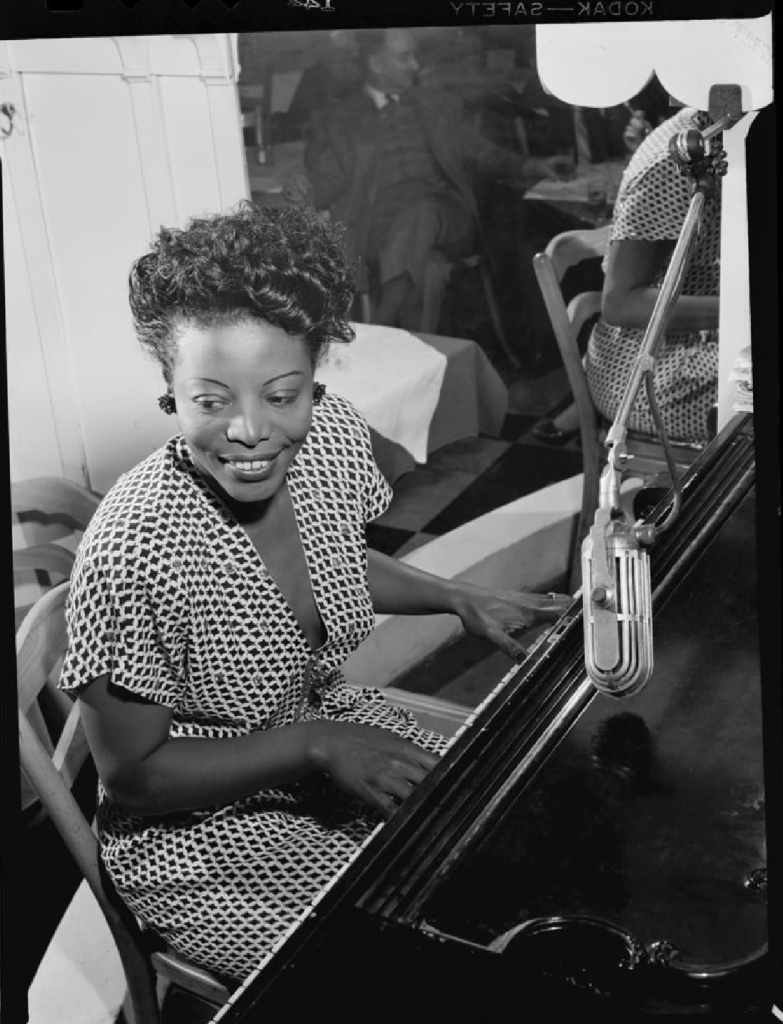
Mary Lou Williams – Trailblazing Jazz Pianist. A pianist and composer, she grew up in Pittsburgh’s East Liberty neighborhood. A prodigy, Williams began performing professionally as a teenager and went on to work with legends Duke Ellington and Benny Goodman. Known for her ability to adapt to evolving jazz styles, Williams made significant contributions to swing, bebop, and sacred jazz.
Art Blakey – Legendary drummer and bandleader. Born in Pittsburgh in 1919, Blakey was a jazz drummer and bandleader who founded the Jazz Messengers. Blakey played a pivotal role in shaping modern jazz and mentoring future legends such as Wayne Shorter and Freddie Hubbard. Known for his explosive playing style and dynamic presence, Blakey helped define the hard bop movement.
Erroll Garner – “Misty.” The pianist and composer, born in Pittsburgh in 1921, became one of the most distinctive voices in jazz with his lush harmonies and improvisational genius, Garner’s most famous composition, “Misty,” became a jazz standard. Despite never learning to read music, Garner’s unique style captivated audiences worldwide.
Stanley Turrentine – Jazz saxophone great. Turrentine was born in Pittsburgh in 1934 and became a leading figure in the soul-jazz movement. Known for his warm, expressive tone, Turrentine collaborated with legends like Jimmy Smith and released iconic albums such as “Sugar.” His upbringing in Pittsburgh’s vibrant jazz scene, alongside other greats such as Mary Lou Williams, shaped his distinctive style.
Ray Brown – Pioneering Jazz Bassist. Born in Pittsburgh in 1926, Brown became one of the most influential musicians in jazz history. With his impeccable technique and unique style, Brown collaborated with legends such as Ella Fitzgerald, Oscar Peterson, and Dizzy Gillespie. His foundational role in jazz ensembles helped define the genre’s rhythm and harmony, earning him widespread acclaim.
Ahmad Jamal – Jazz Pianist and Composer. Jamal was born in Pittsburgh in 1930. Known for his novel approach to rhythm and space, Jamal influenced generations of musicians, including Miles Davis. His album “At the Pershing: But Not for Me” became a jazz classic, showcasing his ability to blend elegance with improvisation. Jamal’s roots in Pittsburgh’s dynamic jazz community shaped his artistry and legacy as one of the genre’s most admired figures.
George Benson – “On Broadway” Jazz Singer. The Grammy-winning jazz guitarist and vocalist was born in Pittsburgh in 1943. A child prodigy, Benson began performing professionally at a young age, blending jazz, soul, and R&B to create a signature sound. His smooth vocals and virtuosic guitar playing earned him widespread acclaim, and hits such as “On Broadway” and “Give Me the Night” became classics. Benson’s influence extends across multiple genres, making him one of the most versatile musicians of his time.
Ray Sprigle – Pulitzer Prize Winner
Sprigle gained national fame for his investigative reporting. The Pittsburgh Post-Gazette writer’s most notable achievement came in 1938 when he revealed that Hugo Black, a Supreme Court justice, had been a member of the Ku Klux Klan. This scoop won him the Pulitzer Prize for reporting. In 1948, Sprigle went undercover as a black man in the segregated South to report on the harsh realities of racial discrimination and wrote the series, “I Was a Negro in the South for 30 Days.”
The Alan I W Frank House – A Bauhaus Treasure
One of a very few private homes designed by Walter Gropius, the founder of the Bauhaus movement in Germany, the Frank House was built in 1940 by industrialist Robert Frank and his wife Cecilia. Coming a few years after Frank Lloyd Wright’s Fallingwater, it was a striking version of modernism made more remarkable for its commission by another Pittsburgh family and friends of the Kaufmanns. Even more remarkable, the home remains intact as it was built, with several hundred pieces of furniture by Marcel Breuer and fabrics by Anni Albers. As such it offers an incredible opportunity to see the work two masters of 20th century architecture, though it is not open to the public and a foundation has been created to restore it.
Rolling Rock Beer
The classic American lager was first brewed in 1939 in Latrobe and became known for its distinctive green bottles and mysterious “33” printed on the label.
Pittsburgh’s Steel Industry and Rivers of Steel
Pittsburgh steel played a pivotal role in supporting the U.S. during World War II. Dubbed the “Arsenal of Democracy,” Pittsburgh produced an unprecedented quantity of steel and other materials essential for the war effort; it is said that western Pennsylvania produced more steel than the Axis powers of Germany and Japan combined. Pittsburgh mills, including those of U.S. Steel and Jones & Laughlin, rapidly adapted to wartime production, and factories operated around the clock, manufacturing everything from tanks and ships to ammunition and aircraft components. The city’s industrial might became a cornerstone of the Allied victory. Workers faced grueling conditions, often enduring long hours and dangerous tasks to meet the government’s demands. Despite these challenges, the workforce, which included an increasing number of women and African Americans, rose to the occasion. This marked a significant shift in the city’s labor dynamics, as necessity redefined traditional roles.
In 1988, a group of citizens wanted to save and memorialize Pittsburgh’s steel heritage and culture, forming a nonprofit called Rivers of Steel. The Rivers of Steel National Heritage Area celebrates the area’s steel history, its contributors and the way of life that imbued it. Rivers of Steel attracts visitors from all over the world to its attractions, tours and events.


